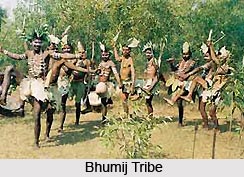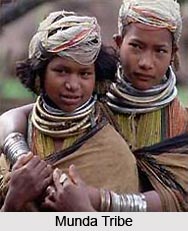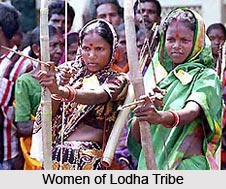Tribal Communities of Medinipur are malodorous of the epicentre of civilization that hardly falls within the ambit of light of progress and development that the so called progressive populace have been granted. The Santhals are the largest group and primal among tribal communities generally the inhabitants of northern and western hilly area of this district belonging to Proto-Australoid race. Their first mention ever had been at the account of Walter Hamilton (1820) who nourished the notion that a poor downtrodden class lived in the jungles, which were named as Santals. In some opinion, `Santal`, word came from `Saont` or `Samanta`. Once, an area of East Medinipur was called `Samantabhum` or `Saont`. Probably, they are the original inhabitants of this region. They also mentioned this place `Sant Disham` or `Sant Desh` in their mythology.
Etymologically `Santal` means inhabitant of `Sant Desh`. Santals are mostly concentrated in Medinipur (North and South) and Jhargram sub-division. Once, it was said that there was a major number of Santal density in Midnapore town and its surrounding places like Kuikota, Keranichati, Abashgarh, Nildanga, Karnagarh. In the period of Chuar Revolt, they were utterly tortured by the British, for which they fled away and sought their refugee in Patharkumkumi, Maupal, Pirakata and surrounding places.
Cleaning of forest, agriculture and digging works are their favourite practice. Once they were sent to Chhabis Pargana for cleansing forests. Some of them settled there permanently. Even today they left for Bardhaman, Hooghly and Nadia in paddy season and it`s yielding and harvesting which is called `namal`.
 In Medinipur district, the venture for educating them was taken by American Baptist Foreign Mission. But their objective was to baptize them as well as to give education. Rev. J. Philips acquired Santali and by his effort Santali songs and rhymes were published in Bengali script (1845). In this very year he started a school for Santhals in Jaleswar.
In Medinipur district, the venture for educating them was taken by American Baptist Foreign Mission. But their objective was to baptize them as well as to give education. Rev. J. Philips acquired Santali and by his effort Santali songs and rhymes were published in Bengali script (1845). In this very year he started a school for Santhals in Jaleswar.
Some missionaries contributed their efforts for educating Santals and developing their language. Rev. J. Philips, Rev. G. Kenan and Rev. L.C. Kitchen were among them. Rev. Philips wrote two valuable books, the first was `Santali Bhasa Siksha` (1850) and second `An Introduction to the Santhali Language` (1852). In his second book, a grammar and a glossary of 5000 words is included. It was treated as the pioneer effort in this field. Then we must mention the name of George Kenan. A fund was created, captioning `George Kenan Fund for Santal Literature`. Rev. Kenan was a member of Medinipur District Education Committee. He wrote the book "Primary Education among Santals of Midnapore`.
In August Movement of 1942, every person of society participated, which was a very frightening signal for British. Santals of this district took part in this movement to set free and to drive away foreign-rulers from our country. Medinipur Adibasi Mahasabha has given the leadership. In this organization, persons like Pargana Manasaram Mandi, Kalicharan Soren, Pargana Surendranath Soren, Pargana Sripati Hansda, Navin Soren, Subodh Soren, Shyamacharan Murmu were attached.
These leaders of Adibasi Mahasabha took their effort to solve the problems of their community. Guided by their advice, tribal stopped paying taxes and revenues. They attacked the excise offices and set ablaze these establishments in Silda, Binpur, Parihati, Jamboni, Dahijuri, Garbeta, Salboni, Goaltore, Ramgarh etc.
 Munda Tribe
Munda Tribe
Munda means head, largely head of a village or habitation. Mundas made their settlement after cleansing off forests. `Patti` means a group of villages. Even a Chief is entitled for a `Patti`, alike a village, he was known as `Manki`, Chief persons of a village are called `Maji`, `Pavani` and `Govet`. Mundas are largely found in Chandri and Maniputi of Jhargram P.S., Jelati in Sankrail P.S., in Chunapara, Narayangarh, Belda, Keshiary, Gopiballavpur-I & II and Belpahari block. Mundas, mostly use `Singh` as their surname. In every Munda village there must be an `akhra`(a place for assembly). Like the `Jaherthan` of Santal communities, there is a place in Munda villages, walled with trees and which is called `Sarna`.
Mundas are mostly of agrarian society. They also absorb themselves in hunting also. But now largely they are labour class. They collect leaves from jungle and make plates, glasses and bowls. Rice and bread are their main food. As they are of hunting nature, they like meats of birds and animals. They produce `Kodo` in barren lands, which is used for making `hanria`(indigenous liquor). They also collect various types of fruits and roots from jungle. But popular customs and rituals of Munda society are decaying day by day. Child marriage is not found in this society but pre-mature marriage occurs often. The proposal of a marriage comes first from the suitor`s end. There is a match-maker. There are some rituals before leaving for marriage. The marriage is arranged in `Chhadnatala` (marriage place), a sal tree and a banana plant are placed in this place with fixing a pitcher and dowry is given to the marriageable daughter, like Santals. A piece of cloth, called `sinai`, is stained with blood from bride and bridegroom and this is touched in their throats and necks. Then comes the phase of `Sindurdan` (Offering vermilion). They make marks on forehead of each other and exchange garlands. Remarriage of widow or ownerless women prevails in Munda society. Such proposals also come from suitor`s end. This type of marriage is called `Sanga Bapla`.
Bhumij Tribe
According to scholars, Bhumij is an offshoot of Munda community. Once, they have lost their entity and acculturated Hindu customs, social and cultural gaps came between these two groups and made this gap permanent. They are concentrated in Gopiballavpur-I, Gopiballavpur-II and Binpur-II(Belpahari) blocks of Paschim Medinipur district. Once Bhumij community is habituated with those dresses of Munda, but today they wear dresses, which are found in labour class. They wore Baja, Banki and Chandrahan and such like ornaments, made of brass and copper. But today they are prone to gold and silver ornaments, even imitation, according to their capacity. They are of peasantry group. This society is patriarchal. They have their own panchayat(local body) and a chief, where social problems are solved or reconsolidated.
There are groups like `Pulgu`, `Hembram`, `Patti` and social emblems in Bhumij society. Inter-lineage marriage is a social taboo. Inter-racial marriage is treated as a punishable deed. Dowry for suitor`s is not customary, but dowry for marriageable girl is an essential practice.
Chief deity of Bhumij group is `Ming bonga` and priest is called `Laya`. There is a custom of offering hens and goats as sacrifice. Bhumij also worship Bajut deity. They also worship `Gonmadhanam`, `Jahirburu` and `Dhunkundra` and such like deities. Among their festivals, `Bandhna`, `Sarhul` and `Karam Parab` are worthy of mention. Dead bodies are cremated and this is a normal custom. However, in case of death caused by pox or cholera, the corpse is thrown in a drain or pit, of a jungle.
Mahali Tribe
Mahali concentrations are found in Jalpaiguri district and in Medinipur district where Mahalis are treated as a separate offshoot of Santal community. They remained separate from Santals in their professions. They are skilled in making basket, tray, bowl etc. from bamboo. Different lineages (gotra) are found in their society, such as, Hembram, Murmu, Hansda, Kisku, Besra, Tudu, Mandi, Baske, Soren, Chanre, Shyama, Gundti, Dungi etc. Their customs and organizations are akin to Santals. In their dresses and ornaments they are identical to Santals also. Women prefer tattoos and men wear `Sikhay`. Like Santals, Mundas and Bhumijs, Mahalis also observe the festivals like Baha, Saharay, Karam, Dhansai, Maghnim etc. Currently they also started arranging Durga puja. Traditionally, they observe Makar Parab and new garments are customary in this festival also.
Koda Community
Koda community is mostly absorbed in digging work. They are treated as a separate offshoot of Mundas. The village chief or the priest is called `Mahata`. He reconciliates every possible grievance and worships as priest. When a new born baby comes in their society, the family observes a ritual of impurity (ashauch) and the purification is done as per custom of the tribal tradition. Koda community also worships several deities, but they are not idolators. They offer goose, hen, lamb and goat as sacrifice to `Garam Thakur`(village deity). They also worship the sylvan deity `Rageswar`.
 Lodha Tribe
Lodha Tribe
Lodha concentrations are found in jungle areas of this district and largely in Ghatal, Tamluk, Jhargram and Medinipur Sadar sub-divisions. They reside almost in 354 villages. They may be called as a hunting class. They even collect fruits, honey etc. from the forest. In some opinion, they belong to pre-Dravidian group. They become habituated with agriculture as deforestation caused demolition in their livelihood. There are nine types of lineage in their society; these are Kotal, Mallik, Nayek, Digar, Bhukta, Paramanik, Dandapat, Ahari and Bhunia. They also have a chief in their village and a priest, who is called Dehari. After the birth of a baby, the impurification (ashauch) phase is started and stays for 21 days. Early marriage is still well practiced in this society. Dowry is given to marriageable daughter. In marriage ceremony the soil of Sidha tree is used customarily. Maternal uncle performs the act of bestow his niece to the bride. Remarriage is acknowledged in this society. They have no festival of their own, so they celebrate Tusu or Bandhna. Male member performs `Changa` dance. Even, they arrange Jhumur and patranach. Female members sing for Tusu days, but they never take part in group dance or songs.
Kheria Tribe
Kherias are the descendants of primitive Kol group. They have physical similarity with them. They are totally illiterate and their language is now in an endangered status. In some respect, they look identical with Lodhas, but their lineage and religious practice is not the same. Kherias also have some groups, such as, Pahari-Kheria, Dudh-Kheria and Dhelki-Kheria. They also have a good practice in hunting; they gather fruits, roots and leaves, honey, logs etc. Kheria woman can be accepted as wife for a Munda suitor, but Munda girl never be married with a Kheria boy. Among their deities, "Gurung" or Sun God is chief. Kherias believe in supernatural power and such like beliefs. They cremated a dead body, sometimes bury it.




















